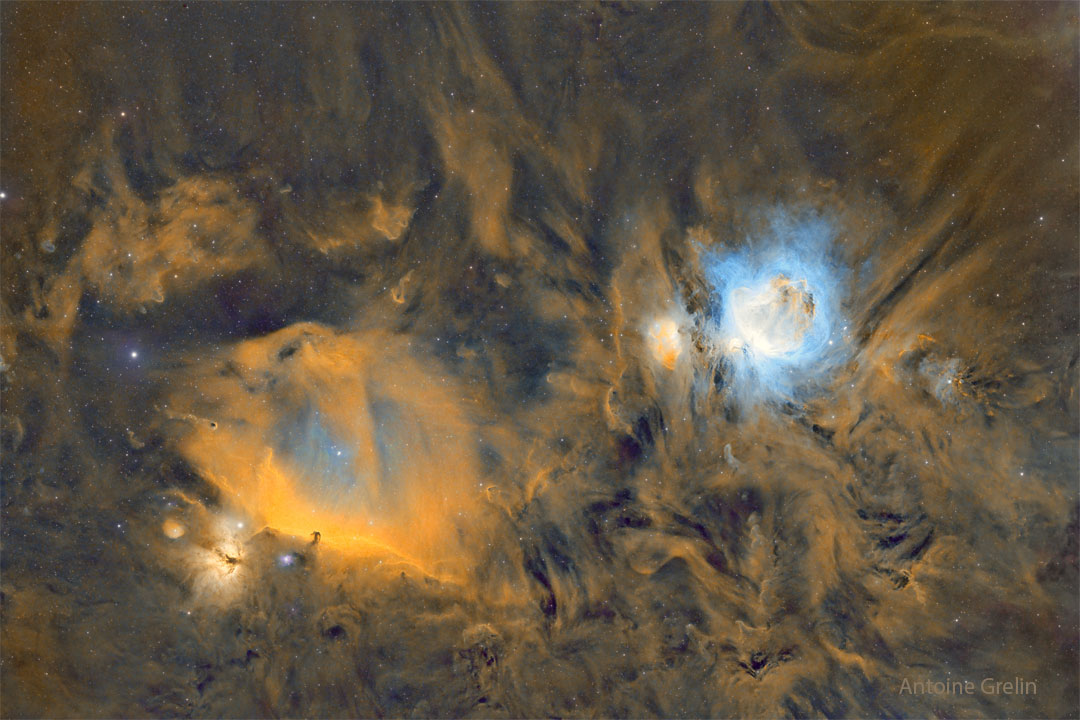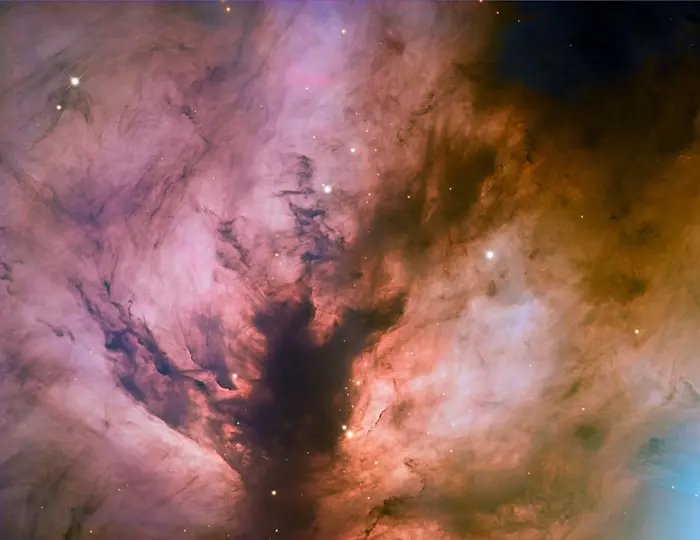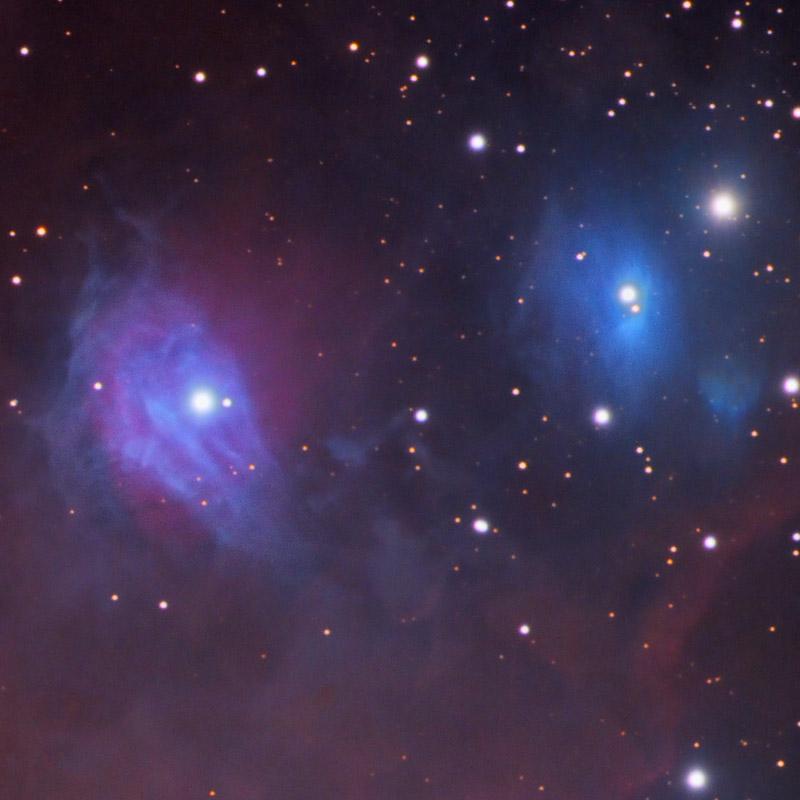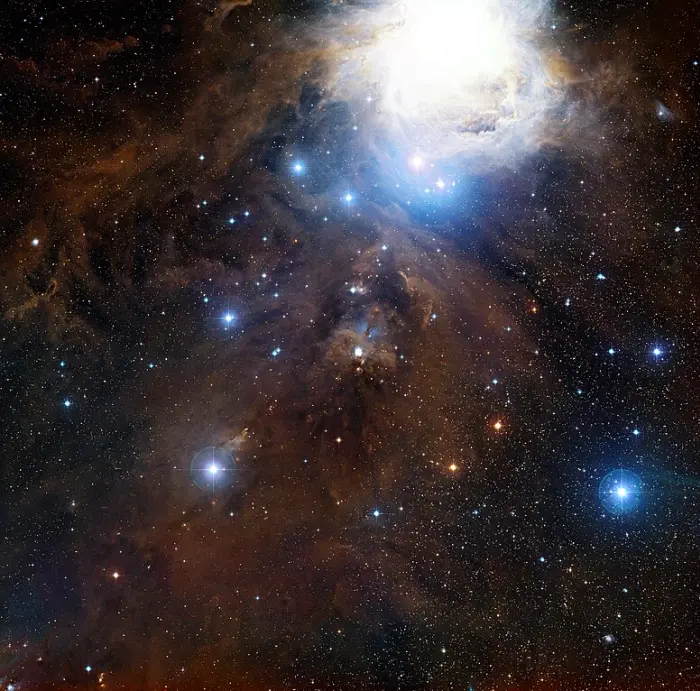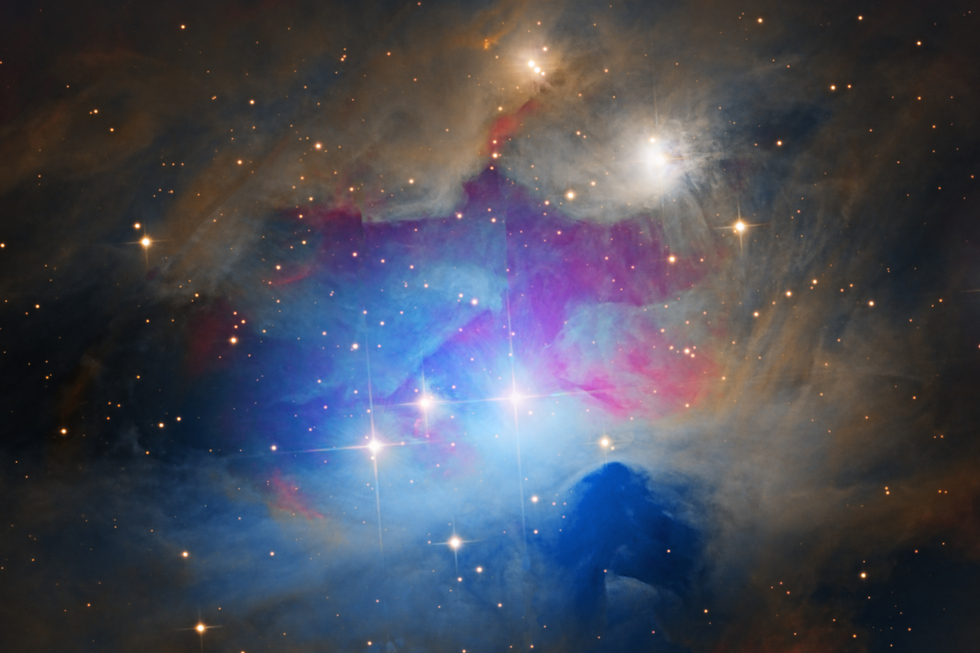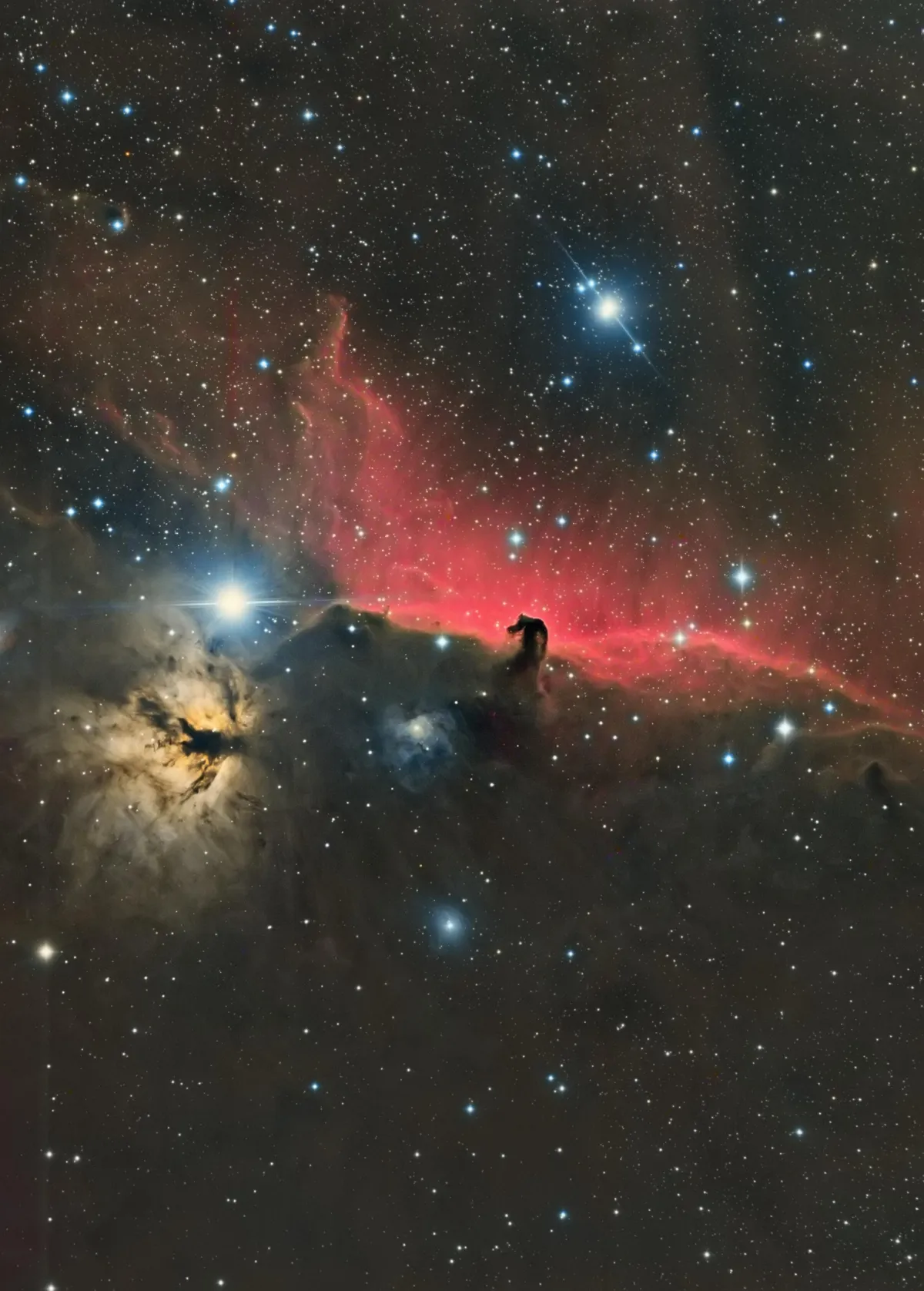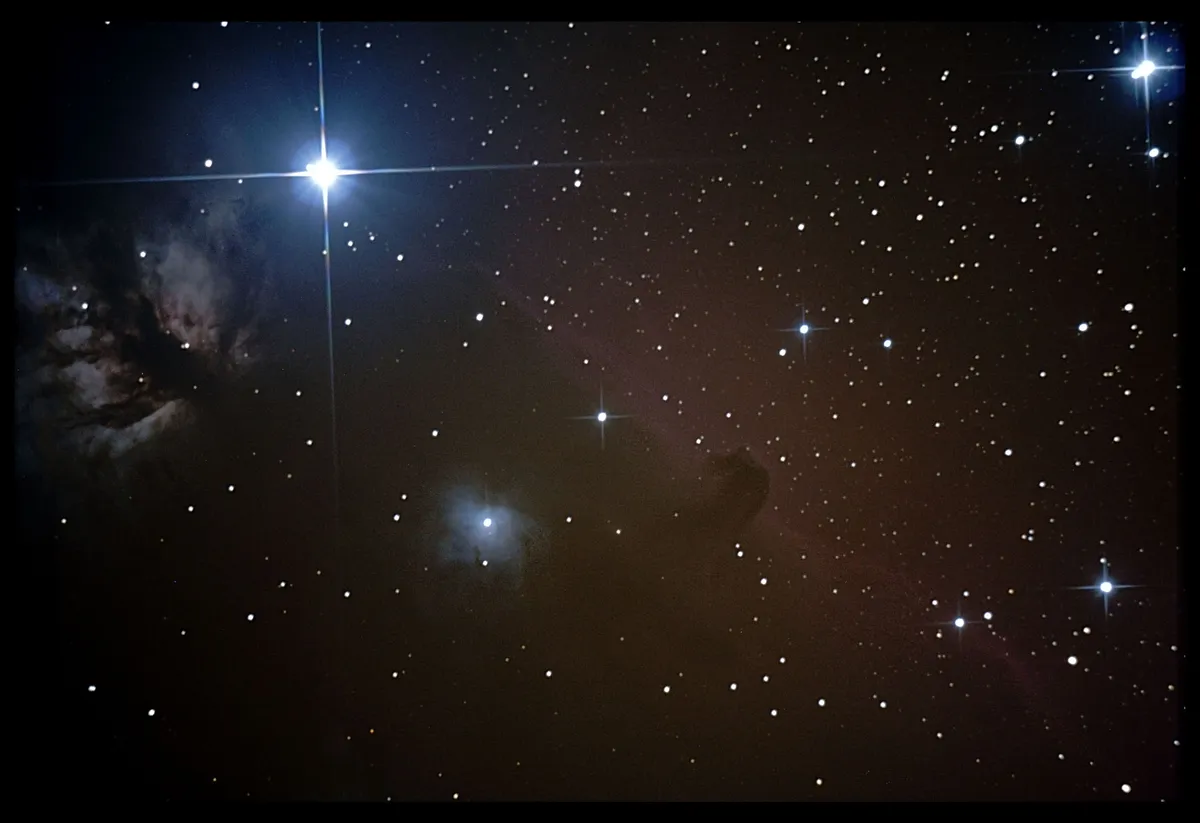Page 1 of 1
APOD: Horsehead and Orion Nebulas (2024 Sep 10)
Posted: Tue Sep 10, 2024 4:06 am
by APOD Robot
 Horsehead and Orion Nebulas
Explanation:
Horsehead and Orion Nebulas
Explanation: The dark
Horsehead Nebula and the glowing
Orion Nebula are contrasting cosmic vistas. Adrift 1,500 light-years away in one of
the night sky's most recognizable
constellations, they appear in opposite corners of the above
stunning mosaic. The familiar
Horsehead nebula appears as a dark cloud, a
small silhouette notched against the long glow of hydrogen -- here shown in gold -- at the lower left.
Alnitak is the easternmost star in
Orion's belt and is seen as the brightest
star just below and to the left of the
Horsehead. To the left of Alnitak is the
Flame Nebula, with clouds of bright emission and
dramatic dark dust lanes. The magnificent emission region, the
Orion Nebula (aka M42), lies at the upper right. Immediately to its left is a prominent
reflection nebula sometimes called the Running Man. Pervasive
tendrils of glowing hydrogen gas are easily
traced throughout the region.
Re: APOD: Horsehead and Orion Nebulas (2024 Sep 10)
Posted: Tue Sep 10, 2024 4:19 am
by ozalba
The brightest star below-left of the Horsehead is HD 37903; Alnitak is just above the Flame Nebula, in this image.
Re: APOD: Horsehead and Orion Nebulas (2024 Sep 10)
Posted: Tue Sep 10, 2024 6:19 am
by Ann
What I like about this APOD is all the details in the surrounding dust.
Note the "pillars" pointing at Sigma Orionis.
The Horsehead Nebula is one of those pillars.
What I specifically like about the APOD is all the "pillars" pointing at Sigma Orionis. Sigma Orionis is a hot O-type star, which, because of its harsh stellar wind and intense ultraviolet light, has cleared a "bubble" around itself. But at the margins of this bubble, "pillars" of gas and dust remain standing, pointing at Sigma Orionis. The Horsehead Nebula is just one of those pillars.
(And I know that Chris insists that the Horsehead Nebula is really the, well, Horse-backside Nebula. How about providing an illustration, Chris?)
Let's take a look at a few of the sights. Let's start with the Horsehead (or the Equine Rear):
Let's move on reflection nebula NGC 2023:
Let's look at the Flame Nebula in different wavelengths:
There is a small round nebula near the Flame Nebula, IC 432, that we can take a look at:
The interesting little nebula NGC 1999 is at far right in the APOD. Maybe you want to read abut it
here.
The Running Man Nebula can be found practicing for the Olympics at the other side of the Orion Nebula:
As for the Orion Nebula, this famous picture by Hubble looks good:
Let's have a look at Sigma Orionis:
And here is a nice picture of Orion's Belt with Alnitak, Alnilam and Mintaka:
Orion's Belt. The stars are, from lower right to upper left,
Alnitak, Alnilam and Mintaka. Credit: Mohammad Nouroozi
And let's have two more pictures of the Horsehead Nebula and surroundings, shall we?
I really recommend
this page if you want to see a ton of Horsehead Nebula pictures!
And now I want a hot dog. The deep yellow color of the APOD gave me a craving for mustard!
Ann
Re: APOD: Horsehead and Orion Nebulas (2024 Sep 10)
Posted: Tue Sep 10, 2024 7:29 am
by FLPhotoCatcher
There is a nebulous area that actually looks like a skull and crossbones. The running man and the Orion nebula are the two eyes.
Re: APOD: Horsehead and Orion Nebulas (2024 Sep 10)
Posted: Tue Sep 10, 2024 12:07 pm
by Christian G.
Ann wrote: ↑Tue Sep 10, 2024 6:19 am
What I specifically like about the APOD is all the "pillars" pointing at Sigma Orionis. Sigma Orionis is a hot O-type star, which, because of its harsh stellar wind and intense ultraviolet light, has cleared a "bubble" around itself. But at the margins of this bubble, "pillars" of gas and dust remain standing, pointing at Sigma Orionis. The Horsehead Nebula is just one of those pillars.
Why does it seem that, unlike Sigma Orionis with the Horsehead Nebula, the equally hot Alnitak isn't really "carving" anything in the Flame Nebula? The dark dust pillars or lanes in its center aren't pointing in any way towards it, or am I misinterpreting what I'm seeing?
Re: APOD: Horsehead and Orion Nebulas (2024 Sep 10)
Posted: Tue Sep 10, 2024 1:04 pm
by RJN
The star Alnitak was incorrectly identified in the original APOD text. The text has now been corrected on the main NASA APOD. We apologize for the mistake. - RJN
Re: APOD: Horsehead and Orion Nebulas (2024 Sep 10)
Posted: Tue Sep 10, 2024 1:26 pm
by Ann
Christian G. wrote: ↑Tue Sep 10, 2024 12:07 pm
Ann wrote: ↑Tue Sep 10, 2024 6:19 am
What I specifically like about the APOD is all the "pillars" pointing at Sigma Orionis. Sigma Orionis is a hot O-type star, which, because of its harsh stellar wind and intense ultraviolet light, has cleared a "bubble" around itself. But at the margins of this bubble, "pillars" of gas and dust remain standing, pointing at Sigma Orionis. The Horsehead Nebula is just one of those pillars.
Why does it seem that, unlike Sigma Orionis with the Horsehead Nebula, the equally hot Alnitak isn't really "carving" anything in the Flame Nebula? The dark dust pillars or lanes in its center aren't pointing in any way towards it, or am I misinterpreting what I'm seeing?
Good question. Indeed, a very good question. It took me a long time to accept that Alnitak had anything to do with the Flame Nebula, because I couldn't see any visual signs that the Flame Nebula was being affected by the hot bright star in any way.
As you can see in Hypatia Alexandria's image, there are no obvious "pillars" at all that are pointing at Alnitak. Also note that the color of the Flame Nebula is different than the color of red nebula behind the Horsehead Nebula. The color difference is not so great in Hypatia Alexandria's image, but in other images, the color difference is striking. Because of that, I used to think that the Flame Nebula was not being ionized from outside at all, and that all the light coming from this nebula was highly reddened starlight from young blue stars inside.
And you know what?
I just now checked the Wikipedia entry on the Flame Nebula, and it would seem that I was right!!! Wikipedia said that Alnitak and the Flame Nebula really have nothing to do with one another!!!



Fancy that!!!
Wikipedia wrote:
The bright star Alnitak (ζ Ori), the easternmost star in the Belt of Orion, appears very close to the Flame Nebula in the sky.
But the star and nebula are not physically associated with one another. The Flame Nebula contains a young cluster of stars which includes at least one hot, luminous O-type star labeled IRS 2b. The dense gas and dust in the foreground of the nebula heavily obscures the star cluster inside the nebula, making studies at infrared wavelengths most useful.
Really and honestly, fancy that!!!
Ann
Re: APOD: Horsehead and Orion Nebulas (2024 Sep 10)
Posted: Tue Sep 10, 2024 4:34 pm
by Christian G.
Ann wrote: ↑Tue Sep 10, 2024 1:26 pm
Christian G. wrote: ↑Tue Sep 10, 2024 12:07 pm
Ann wrote: ↑Tue Sep 10, 2024 6:19 am
What I specifically like about the APOD is all the "pillars" pointing at Sigma Orionis. Sigma Orionis is a hot O-type star, which, because of its harsh stellar wind and intense ultraviolet light, has cleared a "bubble" around itself. But at the margins of this bubble, "pillars" of gas and dust remain standing, pointing at Sigma Orionis. The Horsehead Nebula is just one of those pillars.
Why does it seem that, unlike Sigma Orionis with the Horsehead Nebula, the equally hot Alnitak isn't really "carving" anything in the Flame Nebula? The dark dust pillars or lanes in its center aren't pointing in any way towards it, or am I misinterpreting what I'm seeing?
Good question. Indeed, a very good question. It took me a long time to accept that Alnitak had anything to do with the Flame Nebula, because I couldn't see any visual signs that the Flame Nebula was being affected by the hot bright star in any way.
As you can see in Hypatia Alexandria's image, there are no obvious "pillars" at all that are pointing at Alnitak. Also note that the color of the Flame Nebula is different than the color of red nebula behind the Horsehead Nebula. The color difference is not so great in Hypatia Alexandria's image, but in other images, the color difference is striking. Because of that, I used to think that the Flame Nebula was not being ionized from outside at all, and that all the light coming from this nebula was highly reddened starlight from young blue stars inside.
And you know what?
I just now checked the Wikipedia entry on the Flame Nebula, and it would seem that I was right!!! Wikipedia said that Alnitak and the Flame Nebula really have nothing to do with one another!!!



Fancy that!!!
Wikipedia wrote:
The bright star Alnitak (ζ Ori), the easternmost star in the Belt of Orion, appears very close to the Flame Nebula in the sky.
But the star and nebula are not physically associated with one another. The Flame Nebula contains a young cluster of stars which includes at least one hot, luminous O-type star labeled IRS 2b. The dense gas and dust in the foreground of the nebula heavily obscures the star cluster inside the nebula, making studies at infrared wavelengths most useful.
Really and honestly, fancy that!!!
Ann
Good to know! Alnitak's status as blistering O-type supergiant that would burn through any cloud near it is preserved!
Re: APOD: Horsehead and Orion Nebulas (2024 Sep 10)
Posted: Tue Sep 10, 2024 4:39 pm
by Chris Peterson
Ann wrote: ↑Tue Sep 10, 2024 6:19 am
What I like about this APOD is all the details in the surrounding dust.
I don't think we see much dust in this narrowband image. Most of the surrounding structure appears to be ionized hydrogen.
Re: APOD: Horsehead and Orion Nebulas (2024 Sep 10)
Posted: Tue Sep 10, 2024 5:09 pm
by Ann
Chris Peterson wrote: ↑Tue Sep 10, 2024 4:39 pm
Ann wrote: ↑Tue Sep 10, 2024 6:19 am
What I like about this APOD is all the details in the surrounding dust.
I don't think we see much dust in this narrowband image. Most of the surrounding structure appears to be ionized hydrogen.
All right - all the details in the surrounding chaotic gas, then?

Or maybe the gas is not even chaotic, just turbulent?
Ann
Re: APOD: Horsehead and Orion Nebulas (2024 Sep 10)
Posted: Tue Sep 10, 2024 6:28 pm
by bls0326
Ann: Thanks for labels on the APOD picture. Sure helped me identify stuff in this busy area.
Brian
Re: APOD: Horsehead and Orion Nebulas (2024 Sep 10)
Posted: Wed Sep 11, 2024 9:09 pm
by AVAO
Ann wrote: ↑Tue Sep 10, 2024 5:09 pm
Chris Peterson wrote: ↑Tue Sep 10, 2024 4:39 pm
Ann wrote: ↑Tue Sep 10, 2024 6:19 am
What I like about this APOD is all the details in the surrounding dust.
I don't think we see much dust in this narrowband image. Most of the surrounding structure appears to be ionized hydrogen.
All right - all the details in the surrounding chaotic gas, then?

Or maybe the gas is not even chaotic, just turbulent?
Ann
Well...quite colorfull making of...
 https://youtu.be/rnf226cdFJc?t=587
https://youtu.be/rnf226cdFJc?t=587
Re: APOD: Horsehead and Orion Nebulas (2024 Sep 10)
Posted: Thu Sep 12, 2024 4:14 am
by Ann
AVAO wrote: ↑Wed Sep 11, 2024 9:09 pm
Ann wrote: ↑Tue Sep 10, 2024 5:09 pm
Chris Peterson wrote: ↑Tue Sep 10, 2024 4:39 pm
I don't think we see much dust in this narrowband image. Most of the surrounding structure appears to be ionized hydrogen.
All right - all the details in the surrounding chaotic gas, then?
Or maybe the gas is not even chaotic, just turbulent?
Ann
Well...quite colorfull making of...
 https://youtu.be/rnf226cdFJc?t=587
https://youtu.be/rnf226cdFJc?t=587
Oh yuck!!! Horrible!



You can't use narrowband imagery to create good-looking and at least reasonably accurate color images of nebulas!
Ann
 Horsehead and Orion Nebulas
Horsehead and Orion Nebulas